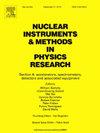Effect of NO annealing on radiation detection performance of Ni/SiO2/4H-SiC MOS capacitors
IF 1.4
3区 物理与天体物理
Q3 INSTRUMENTS & INSTRUMENTATION
Nuclear Instruments & Methods in Physics Research Section A-accelerators Spectrometers Detectors and Associated Equipment
Pub Date : 2024-11-10
DOI:10.1016/j.nima.2024.170073
引用次数: 0
Abstract
In this study, Ni/SiO2/4H-SiC metal-oxide-semiconductor (MOS) devices were fabricated, achieving high-energy resolution for alpha particle radiation detection. The SiO2/4H-SiC interface was treated with two different methods: i) annealing in N2 environment, ii) annealing in NO environment. Devices manufactured using the former method show lower dark currents than the latter. This difference is due to a decrease in trap density at the SiO2/4H-SiC interface caused by NO annealing, resulting in a higher barrier height for the device. The NO-30 exhibited a much higher energy resolution of 0.46%@5486 keV compared to 0.95%@5486 keV observed in N2-30, despite both devices exhibiting good energy linearity in response to alpha particles. The SiO2/4H-SiC interface trap density revealed a significant decrease after NO treatment, indicating NO treatment can effectively improve the electrical performance of 4H-SiC MOS devices. CCE analysis showed the NO-30 had a lower surface recombination field (13000 V/cm) compared to N2-30 (35000 V/cm), which improved the charge collection efficiency and energy resolution. This study provides a practical approach for enhancing the energy resolution of 4H-SiC MOS detectors.
氮氧化物退火对 Ni/SiO2/4H-SiC MOS 电容器辐射探测性能的影响
本研究制作了 Ni/SiO2/4H-SiC 金属氧化物半导体 (MOS) 器件,实现了α粒子辐射探测的高能量分辨率。SiO2/4H-SiC 界面采用两种不同的方法进行处理:i) 在 N2 环境中退火;ii) 在 NO 环境中退火。使用前一种方法制造的器件比使用后一种方法制造的器件显示出更低的暗电流。这种差异是由于氮气退火导致二氧化硅/4H-碳化硅界面的陷阱密度降低,从而使器件的势垒高度升高。与 N2-30 中观察到的 0.95%@5486 keV 的能量分辨率相比,NO-30 的能量分辨率更高(0.46%@5486 keV),尽管这两种器件在响应α粒子时都表现出良好的能量线性。经过 NO 处理后,SiO2/4H-SiC 界面阱密度显著降低,这表明 NO 处理能有效改善 4H-SiC MOS 器件的电气性能。CCE分析表明,与N2-30(35000 V/cm)相比,NO-30的表面重组场(13000 V/cm)更低,从而提高了电荷收集效率和能量分辨率。这项研究为提高 4H-SiC MOS 探测器的能量分辨率提供了一种实用方法。
本文章由计算机程序翻译,如有差异,请以英文原文为准。
求助全文
约1分钟内获得全文
求助全文
来源期刊
CiteScore
3.20
自引率
21.40%
发文量
787
审稿时长
1 months
期刊介绍:
Section A of Nuclear Instruments and Methods in Physics Research publishes papers on design, manufacturing and performance of scientific instruments with an emphasis on large scale facilities. This includes the development of particle accelerators, ion sources, beam transport systems and target arrangements as well as the use of secondary phenomena such as synchrotron radiation and free electron lasers. It also includes all types of instrumentation for the detection and spectrometry of radiations from high energy processes and nuclear decays, as well as instrumentation for experiments at nuclear reactors. Specialized electronics for nuclear and other types of spectrometry as well as computerization of measurements and control systems in this area also find their place in the A section.
Theoretical as well as experimental papers are accepted.

 求助内容:
求助内容: 应助结果提醒方式:
应助结果提醒方式:


